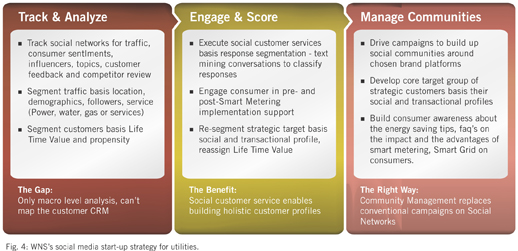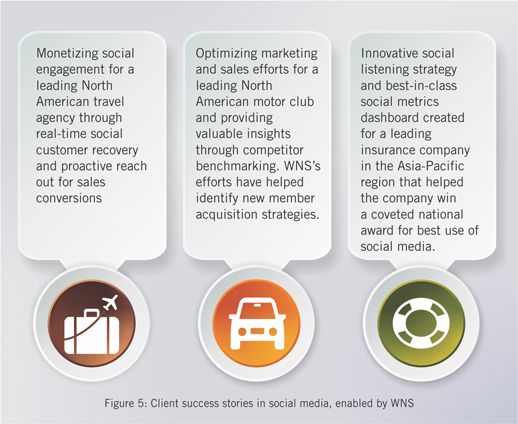It happens to be the number 1 activity on the Internet&hellip
It is now a habit for most of us living on this planet, believe experts…
More than 90 percent of marketers are leveraging its power to take their brands to their consumers and build their businesses…
The social media phenomenon has indeed has outlived expectations and proved that it’s not a mere fad. For the average consumer, social media has evolved into a habit and that’s the shift businesses are trying to tap to engage with the customer, build brand visibility and popularity, offer customer service, generate leads, and sell their products and services.
Most consumer-focused industries such as retail & CPG, media and entertainment, travel and leisure, insurance and banking are actively leveraging the power of this new-age medium.
For the utility industry too, the shift in consumer behavior and the preference for social media is increasingly becoming apparent. Consider this: A recent survey conducted by Pike Research estimates that 57 million people used social media in 2011 to engage with utilities. It estimates that by 2017, the number will rise to 624 million. In the energy and utility industry, blogs and forums account for 43 percent of social channel usage. Twitter accounts for 39 percent of social channel usage as a large number of general energy and utilities consumers use it to register complaints and ask for technical support. Newsfeeds and other channels account for the remaining 18 per cent of social channel usage.
Driven by this clear shift in consumer behavior and attitude, utilities are completely overhauling the traditionalist approach of communicating with customers through letters. They are now taking the new route of posts, blogs and newsfeeds. An increasing number of utilities are integrating their presence across Twitter, Facebook, Instagram and YouTube with their marketing strategy and in fact using social media as a part of their marketing channels.
However, what’s more important is, utilities must gradually move to strategically align social media with their contact center practice for delivering uniform customer service across all channels.
People usually share provider-related sentiments, be it positive, negative or neutral, with a larger customer base on social media. From this base of customers, utilities can identify influencers and detractors and can engage with them proactively to drive superior customer service and nurture loyalty
With customers using social media to make decisions on what to buy and who they buy from, utility companies have to consider their social media strategy as an important customer engagement and retention tool.
Success stories of leveraging social media are galore in a number of industries. In the banking industry, My bank tracker has emerged as a popular financial aggregator Website which helps consumers make smarter banking decisions based on consumer reviews, mostly from social media channels. In the travel & leisure industry, sites like Trip Advisor and major influencers across social media channels are influencing consumers to make the right decisions based on reviews majorly from social media chann
To start with, utilities can look at implementing some of the best-practices followed by other consumer-facing indust
Guidelines for ‘Going Social’
To stay ahead in the game, utility companies will need to build a social media strategy that incorporates aspects of engaging with consumer, building awareness, educating the consumer and offering customer service.
1. Build Consumer Connect: Most often a utility’s social media practice starts with outage notification and communication. Utility companies use this channel to proactively inform customers about a planned outage and quickly respond to a large base of customers regarding an outage, breakdown or disruption due to natural calamities. During the hurricane Sandy in 2012, a number of utility providers took to Twitter and cumulatively 20 million Tweets were posted during and after the calamity.
Utility companies are increasingly integrating social media communication with their Customer Relationship Management (CRM) function. When there is a power outage or a gas shortage in any area, the Tweets go out in a few seconds, followed by calls, e-mails and physical customer care visits in the next few hours. With early trigger from social media, the utility can optimize its contact center workforce and systematically increase or decrease it, thereby reducing volatility due to bench or shortage.
Clearly, social media is not a stand-alone activity and it needs to be aligned with the broader customer interaction strategy to ensure a consistent approach across all channels, be it through the contact center, Twitter, Facebook or in-person interaction.
2. Create Customer Awareness: The awareness level among customers is far from what utilities would like it to be. Many customers are only partially aware of what their smart meters can actually do. Utility companies are using YouTube and Facebook to educate customers on topics such as energy management, advantages of smart meters and industry trends. Social media is also being utilized to generate user-specific awareness regarding changes in pricing, billing or even allowing customers to design their bills.
Smart meter customer awareness revolves around increasing the consumer’s awareness on issues such as: “what is in it for the consumer”, “how can the consumer manage consumption”, “how will the consumer be impacted during installation”, “FAQs on post smart metering installation support”, or “how will smart metering create a better tomorrow both for them and the industry?”
3. Create Brand Awareness: In the words of Scott Cook, founder of Intuit, a brand is no longer what we tell the consumer it is – it is what consumers tell each other it is. This thinking manifests itself most strongly in social media than anywhere else. Customers are increasingly using social media to build or destroy the reputation of their service providers. Social media presents utility providers with an opportunity to manage brand perception and map customer sentiments towards the brand. This can also be used to calculate the brand’s Net Promoter Score (NPS) that provides a good view of customer loyalty. Brands across industries have used their social media presence to effectively manage customer satisfaction.
4. Offer Energy Advice & Tips: Social media can be effectively used to educate customers about energy saving and good use of electric equipment in a userfriendly manner. Companies can use this significantly cost-effective platform to reach out to customers rather than adopting the traditional expensive way of creating and managing audio-visual campaigns. This mode can also be used to promote web-based tools to help consumers analyse their monthly usage and work towards a lower bill. Many utility providers are pursuing two-way discussions with customers on ways to save water, energy and natural gas, and the importance of renewable energy. Real-time communication with customers across multiple platforms tends to create better engagement and allow a “virtual” conversation with the customer.
Recommended Social Media Start-Up Strategy for Utilities
For the utility industries, we at WNS recommend a specific social media start-up strategy that focuses on tracking and analyzing; engaging and scoring and managing communities summarized in Fig. 4.

See How WNS is Helping Clients in their Social Media Endeavors and Multi-channel Customer Interactions
WNS is a leading Business Process Management company with wide experience in designing and implementing social media strategies for clients across industries. Some of our key achievements as enablers of social media strategy and implementation across industries are highlighted in Fig. 5.

WNS has proven industry-specific capabilities in the social media space. With more than 26,000 employees across 33 global delivery centers, the company has been working with over 200 clients to help them outperform in their business.
WNS brings an edge in its partnership with utility companies because of its deep-domain knowledge and experience in the industry. Coupled with its industry-leading social media capabilities, WNS can help utility companies align their social media strategy to their customer engagement needs.
Disclaimer: This document makes descriptive reference to trademarks that may be owned by others. The use of such trademarks herein is not an assertion of ownership of such trademarks by WNS and is not intended to represent or imply the existence of an association between WNS and the lawful owners of such trademarks.